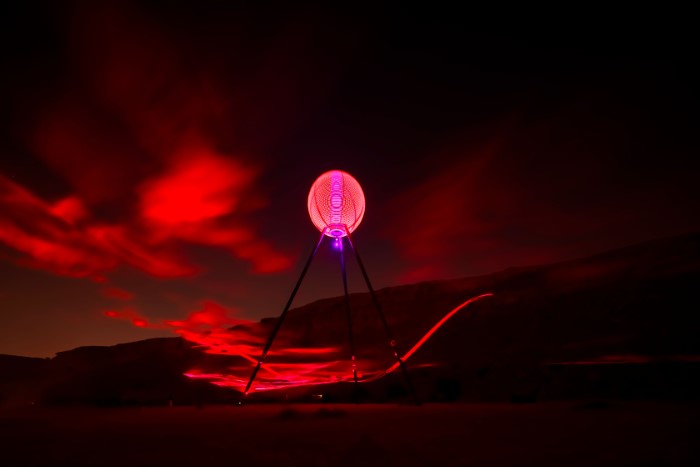Tuesday, December 12, 2023

The world’s largest light art festival, Noor Riyadh, has made a triumphant return to the Saudi capital, completely transforming the city with a breathtaking array of public art installations. This third edition of the festival, running until December 16, showcases over 120 artworks by more than 100 artists from more than 35 countries.
Under the guidance of Lead Curator Jérôme Sans and Curators Pedro Alonzo, Fahad Bin Naif, and Alaa Tarabzouni, this year’s festival explores the theme “The Bright Side of the Desert Moon,” highlighting light as a unifying force that sustains, comforts, and connects us all. The artworks are scattered across five main hubs and various other locations throughout Riyadh City, with the central hub situated at the King Abdullah Financial District (KAFD). Additional hubs include JAX District, Salam Park, Wadi Hanifa, and Wadi Namar.
French curator Jérôme Sans points out that these diverse environments within the five hubs provide artists with a range of opportunities to interpret the theme in various ways. He describes Riyadh as a burgeoning metropolis rising from a vast arid landscape, in sync with the exhibition’s goal of showcasing a world in constant transformation, akin to a whirlwind in the desert.
Sans elaborates, “The city’s scale and its diverse landscapes allow us to tell a multi-chaptered story: from the ultra-modern setting of KAFD to the artistic hub of JAX, the lush artificial nature of Salam Park, the waterfalls of Wadi Namar, and the desert surroundings of Wadi Hanifa.”
In reflecting on the theme, Sans adds, “The desert serves as a metaphor for today’s metacities, where individuals can easily become lost in the crowd. Similar to the vast, ever-changing realm of the metaverse and today’s rapidly evolving technologies, the desert symbolizes the myriad new realities coexisting in our lives. In this highly interconnected world, individuals have never been so disconnected. The exhibition explores and challenges this vision of the desert, using it as a platform to reconsider our relationships and reconnect.”
Mexican curator Pedro Alonzo emphasizes that, despite working across different sites, the curatorial team focused on a unified approach, creating “One voice” through dialogue with each other. Alonzo distinguishes Noor Riyadh from other art festivals by highlighting its primary focus on the people of Riyadh. He praises the festival organizers for their deep understanding of the local audience, which guided artist selection and artwork placement.
Alonzo hopes that the art installations in the five hubs, regularly visited by the public, will surprise and enhance visitors’ experiences, even if they initially don’t recognize the artwork. He aspires to elevate visitors’ evenings, bringing them joy and a new perspective on their familiar surroundings.
Saudi curator Fahad bin Naif, a native of Riyadh, provides a unique perspective on these locations, highlighting Riyadh’s growing prominence as a cultural capital competing with global counterparts. He notes that each edition of Noor Riyadh surpasses the previous one, growing in scale, featuring more artists, and fostering international-local curator collaborations, which encourage cross-cultural dialogue.
Curator Alaa Tarabzouni, also from Riyadh, emphasizes the special intersection between architecture and art in this year’s Noor Riyadh. She appreciates the festival’s role in reintroducing the city and its main hubs to the public and its commitment to providing an equal platform for emerging, international, and local artists.
Running concurrently with Noor Riyadh in JAX District until March 2, 2024, is the exhibition “Refracted Identities, Shared Futures,” curated by Neville Wakefield and Assistant Curator Maya Al Athel. This exhibition explores how light shapes human and cultural identities.
British curator Neville Wakefield explains the sub-theme for this year’s exhibition, “Refracted identities: Shared Futures,” and his strategy of embracing a diverse range of artists and artworks that speak to common themes. The exhibition is divided into three thematic sections: Cosmos, Temporality, and Connectivity, aiming to foster dialogue among Saudi, regional, and international artists.
Wakefield underscores the significance of light art as a reflection of our evolving communication landscape and societal transformation. He believes light has become a symbol of information in our modern era, making light art a direct reflection of the way we adapt to technological and social change, promoting communication and shared experiences.
Maya Al Athel, Saudi curator, emphasizes how light transforms Riyadh, enhancing its cultural identity and engaging the public. She praises Noor Riyadh for its inclusivity, aiming to touch diverse audiences with the transformative power of light.
Noor Riyadh is part of Riyadh Art, a public art initiative with the goal of nurturing local talent and boosting Saudi Arabia’s cultural economy. Riyadh Art envisions transforming the Saudi capital into a “gallery without walls” through over 1,000 public art installations across the city through ten programs and two annual events.
Across its editions, Noor Riyadh has brought joy to the city and provided millions of visitors with the opportunity to experience world-class light art while rediscovering Riyadh from a fresh perspective. In 2022, Noor Riyadh celebrated numerous achievements, including hosting 2.8 million visitors and earning six Guinness World Records, one of which was for the world’s largest celebration of light art.
The third edition of Noor Riyadh coincides with Riyadh’s selection as the host city for World Expo 2030, making it only the second Arab city to host the Expo.
Monday, January 1, 2024